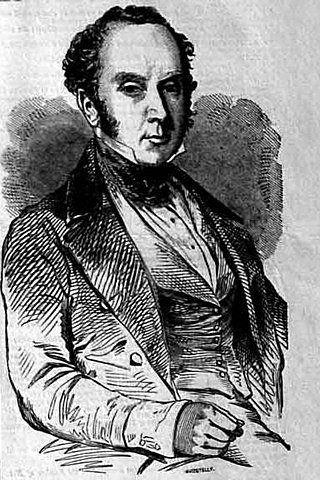
Marquess of Aberdeen and Temair, in the County of Aberdeen, in the County of Meath and in the County of Argyll, is a title in the Peerage of the United Kingdom. It was created on 4 January 1916 for John Hamilton-Gordon, 7th Earl of Aberdeen.

Earl of Derby is a title in the Peerage of England. The title was first adopted by Robert de Ferrers, 1st Earl of Derby, under a creation of 1139. It continued with the Ferrers family until the 6th Earl forfeited his property toward the end of the reign of Henry III and died in 1279. Most of the Ferrers property and the Derby title were then held by the family of Henry III. The title merged in the Crown upon Henry IV's accession to the throne in 1399.

Earl of Galloway is a title in the Peerage of Scotland. It was created in 1623 for Alexander Stewart, 1st Lord Garlies, with remainder to his heirs male bearing the name and arms of Stewart. He had already been created Lord Garlies in the Peerage of Scotland in 1607, with remainder to the heirs male of his body succeeding to the estates of Garlies. This branch of the Stewart family were distant relatives of the Stewart Kings of Scotland.

Earl Ferrers is a title in the Peerage of Great Britain. It was created in 1711 for Robert Shirley, 14th Baron Ferrers of Chartley. The Shirley family descends from George Shirley of Astwell Castle, Northamptonshire. In 1611 he was created a Baronet, of Staunton Harold in the County of Leicester, in the Baronetage of England. He was succeeded by his son Henry, the second Baronet, who married Lady Dorothy Devereux, daughter of Robert Devereux, 2nd Earl of Essex. On the death of her brother Robert Devereux, 3rd Earl of Essex, she became the youngest co-heir to the baronies of Ferrers of Chartley and the barony of Bourchier, which had fallen into abeyance on the death of the third Earl. Shirley was succeeded by his eldest son, the third Baronet. He died unmarried and was succeeded by his younger brother, the fourth Baronet. He was imprisoned in the Tower of London by Cromwell and died there in 1656. On his death the title passed to his eldest son, the fifth Baronet. He died at an early age and was succeeded at birth by his posthumous son, the sixth Baronet.

Earl Waldegrave is a title in the Peerage of Great Britain. It was created in 1729 for James Waldegrave, 2nd Baron Waldegrave.

Earl of Buckinghamshire is a title in the Peerage of Great Britain. It was created in 1746 for John Hobart, 1st Baron Hobart.

Earl of Chichester is a title that has been created three times, twice in the Peerage of England and once in the Peerage of the United Kingdom. The current title was created in the Peerage of the United Kingdom in 1801 for Thomas Pelham, 2nd Baron Pelham of Stanmer.

Earl of Lonsdale is a title that has been created twice in British history, firstly in the Peerage of Great Britain in 1784, and then in the Peerage of the United Kingdom in 1807, both times for members of the Lowther family.

Baron Monson, of Burton in the County of Lincoln, is a title in the Peerage of Great Britain. It was created in 18th century for Sir John Monson, 5th Baronet. The Monson family descends from Thomas Monson, of Carleton, Lincolnshire. He sat as Member of Parliament for Lincolnshire, Castle Rising and Cricklade. On 29 June 1611 he was created a Baronet, of Carleton in the County of Lincoln, in the Baronetage of England. His eldest son, the second Baronet, fought as a Royalist during the Civil War and also represented Lincoln in the House of Commons.

George Carr Glyn, 1st Baron Wolverton was a banker with interests in the railways, a partner in the family firm of Glyn, Mills & Co., which was reputed to be the largest private bank in London.

George Grenfell Glyn, 2nd Baron Wolverton PC, was a British Liberal politician. He held office in three of the Liberal administrations of William Gladstone.
There have been three baronetcies created for members of the Glyn family, two in the Baronetage of Great Britain and one in the Baronetage of the United Kingdom.

Frederick Glyn, 4th Baron Wolverton, was a British banker and Conservative politician. He served as Vice-Chamberlain of the Household under Arthur Balfour from 1902 to 1905.
Captain Sidney Carr Glyn was a British Liberal Party politician.
The Hon. Pascoe Charles Glyn, was a British businessman and Liberal politician.

Sir Richard Glyn, 1st Baronet was a British banker and politician, who together with Joseph Vere and Thomas Hallifax founded the Bank of Vere, Glyn & Hallifax, which evolved into Williams & Glyn's Bank.
Sir Richard Carr Glyn, 1st Baronet was a British banker and politician.

Robert Wellesley Grosvenor, 2nd Baron Ebury was a British politician.

Edward Carr Glyn was an Anglican bishop in England in the late 19th century and the early 20th century. He was the Bishop of Peterborough from 1897 to 1916.
 George Carr Glyn, 1st Baron Wolverton (1797–1873)
George Carr Glyn, 1st Baron Wolverton (1797–1873)  George Grenfell Glyn, 2nd Baron Wolverton (1824–1887)
George Grenfell Glyn, 2nd Baron Wolverton (1824–1887) Henry Richard Glyn, 3rd Baron Wolverton (1861–1888)
Henry Richard Glyn, 3rd Baron Wolverton (1861–1888) Frederick Glyn, 4th Baron Wolverton (1864–1932)
Frederick Glyn, 4th Baron Wolverton (1864–1932)  John Patrick Riversdale Glyn, 6th Baron Wolverton (1913–1988)
John Patrick Riversdale Glyn, 6th Baron Wolverton (1913–1988)  Christopher Richard Glyn, 7th Baron Wolverton (1938–2011)
Christopher Richard Glyn, 7th Baron Wolverton (1938–2011)








